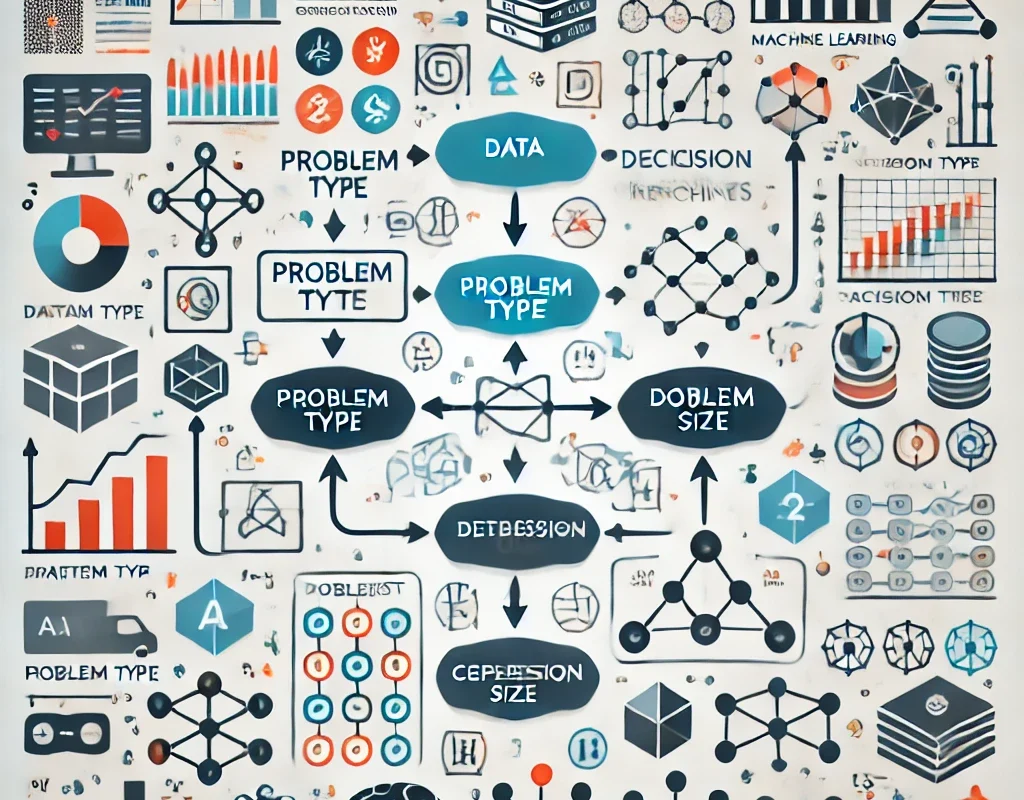Choosing the right machine learning algorithm can often feel like finding a needle in a haystack. With so many options available and each tailored for specific tasks, it’s critical to choose one that fits the unique characteristics of your data and the problem at hand. Making the wrong choice may lead to suboptimal results, longer training times, and inaccurate predictions. This comprehensive guide will walk you through the key considerations and provide an approach to selecting the right algorithm for your project.
Understanding the Basics of Machine Learning Algorithms
Before diving into the specifics of choosing a machine learning algorithm, it’s essential to understand the broader context. Machine learning (ML) algorithms can be broadly categorized into supervised, unsupervised, semi-supervised, and reinforcement learning. Each of these categories serves different types of problems and data structures.
- Supervised Learning: This type of algorithm is used when the outcome (or label) for each data point is known. Common supervised learning algorithms include decision trees, support vector machines (SVM), and linear regression.
- Unsupervised Learning: Unsupervised algorithms are used when the data is not labeled. These algorithms are often employed for clustering and pattern detection, with k-means clustering and principal component analysis (PCA) being popular choices.
- Reinforcement Learning: This technique is used when the model must learn through trial and error, often with a reward system. It is heavily used in robotics and game theory.
- Semi-supervised Learning: This method is a blend of supervised and unsupervised learning, using a small amount of labeled data and a large amount of unlabeled data.
Data Size and Algorithm Complexity
The size and structure of your dataset play a crucial role in determining the most appropriate machine learning algorithm. Some algorithms perform well with small datasets, while others excel with large, complex data structures.
- Small Datasets: If you’re working with a small dataset, simpler algorithms like decision trees, logistic regression, or k-nearest neighbors (KNN) often perform better. These algorithms are less prone to overfitting, especially when data is limited.
- Large Datasets: Algorithms like neural networks, gradient boosting, or random forests tend to perform well with larger datasets. These algorithms can capture more complex relationships in the data, but they also require more computational power and time.
In cases where your dataset contains millions of data points, consider algorithms that can be distributed across multiple machines, such as stochastic gradient descent (SGD) or deep learning frameworks like TensorFlow and PyTorch.
The Nature of Your Problem: Regression vs. Classification
One of the primary factors to consider when choosing a machine learning algorithm is whether you’re dealing with a regression or classification problem. Both require different approaches and have algorithms tailored to their specific needs.
- Regression Problems: In regression tasks, the goal is to predict a continuous output. Linear regression, support vector regression (SVR), and decision trees are commonly used for this type of problem. If your data is complex or non-linear, consider more advanced algorithms like random forests or neural networks.
- Classification Problems: Classification tasks involve predicting discrete categories. For example, determining whether an email is spam or not. Algorithms like logistic regression, naive Bayes, support vector machines, and random forests are commonly used for classification tasks. For high-dimensional data, consider algorithms like SVM or deep learning.
Accuracy vs. Interpretability
Different algorithms offer varying trade-offs between accuracy and interpretability. In some projects, having a model that can be easily interpreted is more important than achieving the highest possible accuracy. In other cases, maximizing accuracy might be your top priority.
- Interpretability: Simple algorithms such as decision trees and logistic regression are easy to interpret and provide clear insights into how predictions are made. These are often chosen in applications where understanding the decision process is critical, such as in healthcare or finance.
- Accuracy: More complex algorithms, such as neural networks and ensemble methods (e.g., random forests or gradient boosting), generally provide higher accuracy at the cost of being harder to interpret. These are ideal when the priority is maximizing predictive power, as seen in domains like image recognition or natural language processing (NLP).
Training Time and Computational Resources
The computational complexity of a machine learning algorithm can vary significantly. Some algorithms, like KNN and decision trees, are quick to train, even on modest hardware. Others, such as neural networks and support vector machines, may require significant computational resources, particularly if the dataset is large or the model architecture is complex.
If training time or computational resources are a concern, consider the following:
- Fast to Train: Linear regression, logistic regression, decision trees, and KNN are generally faster to train, making them suitable for projects with limited time or computational resources.
- Resource-Intensive: Neural networks, support vector machines, and ensemble methods can be resource-intensive and may require GPU acceleration or cloud computing resources to train efficiently. Deep learning models, in particular, can take days or even weeks to train on very large datasets.
The Dimensionality of the Data
Dimensionality refers to the number of features or variables present in your dataset. High-dimensional datasets can be challenging for some machine learning algorithms, as they may struggle to separate relevant signals from noise.
- Low-Dimensional Data: Algorithms like decision trees, KNN, and linear regression work well with low-dimensional datasets. These methods can find clear patterns when there are only a few features to consider.
- High-Dimensional Data: When dealing with high-dimensional datasets, algorithms like support vector machines, random forests, and neural networks excel. Additionally, dimensionality reduction techniques such as PCA can help simplify the problem and improve algorithm performance.
Overfitting and Regularization
Overfitting occurs when an algorithm performs exceptionally well on training data but poorly on unseen test data. This often happens when the model is too complex relative to the amount of training data, causing it to “memorize” the data rather than learn from it.
- Algorithms Prone to Overfitting: Decision trees, KNN, and neural networks can sometimes overfit the training data, especially when they are overly complex. Regularization techniques, such as L2 regularization (used in ridge regression) or pruning (for decision trees), can help mitigate overfitting.
- Regularization Techniques: Many algorithms offer built-in regularization techniques to reduce overfitting. Ridge regression, Lasso, and elastic net are good examples of algorithms that include regularization to prevent overfitting while still capturing essential patterns in the data.
Balancing Bias and Variance
When choosing an algorithm, you must consider the trade-off between bias and variance. Bias refers to the error introduced by simplifying assumptions in the model, while variance refers to the model’s sensitivity to small fluctuations in the training data.
- High-Bias Algorithms: Linear regression and naive Bayes are considered high-bias algorithms, meaning they make strong assumptions about the underlying data patterns. They may underfit the data but tend to be more stable when used with new data.
- High-Variance Algorithms: Neural networks and decision trees are high-variance algorithms, meaning they can fit the training data very closely, potentially leading to overfitting. These algorithms require more careful tuning and regularization to prevent poor generalization to unseen data.
Hyperparameter Tuning and Model Selection
Most machine learning algorithms have hyperparameters that require tuning to optimize performance. Hyperparameters are settings that govern the algorithm’s behavior and must be set before the training process begins.
- Simple Hyperparameters: Algorithms like logistic regression and KNN have relatively few hyperparameters to tune, making them easier to deploy quickly. In some cases, default hyperparameters will yield satisfactory results.
- Complex Hyperparameters: Neural networks and support vector machines, on the other hand, have numerous hyperparameters that must be tuned to achieve optimal performance. Techniques like grid search, random search, or Bayesian optimization can help find the best hyperparameters for your model.
Evaluation Metrics for Algorithm Selection
Different algorithms perform better under different evaluation metrics, depending on the type of problem and data you’re working with. The choice of evaluation metric can significantly impact your algorithm selection.
- Classification Metrics: For classification problems, accuracy is often the most straightforward metric. However, for imbalanced datasets, precision, recall, F1-score, or the area under the ROC curve (AUC-ROC) may be more informative.
- Regression Metrics: In regression tasks, common evaluation metrics include mean absolute error (MAE), mean squared error (MSE), and R-squared. Different algorithms might excel under different metrics, so it’s essential to choose one that aligns with your project’s goals.
Scalability and Future Needs
Finally, consider the long-term scalability of your model. If your dataset is expected to grow significantly over time, you need an algorithm that can scale efficiently. Some algorithms, like linear models or logistic regression, scale linearly with the size of the data. Others, like neural networks and ensemble methods, may struggle with very large datasets unless carefully optimized.
You can also read; How to Implement AI in Business for Enhanced Efficiency
How to Choose the Right Machine Learning Algorithm
Choosing the right machine learning algorithm is a balance of multiple factors, including the nature of your data, the problem you’re trying to solve, and your computational resources. There is no one-size-fits-all solution, but by understanding the strengths and limitations of different algorithms, you can make an informed choice that maximizes the performance and efficiency of your project.



